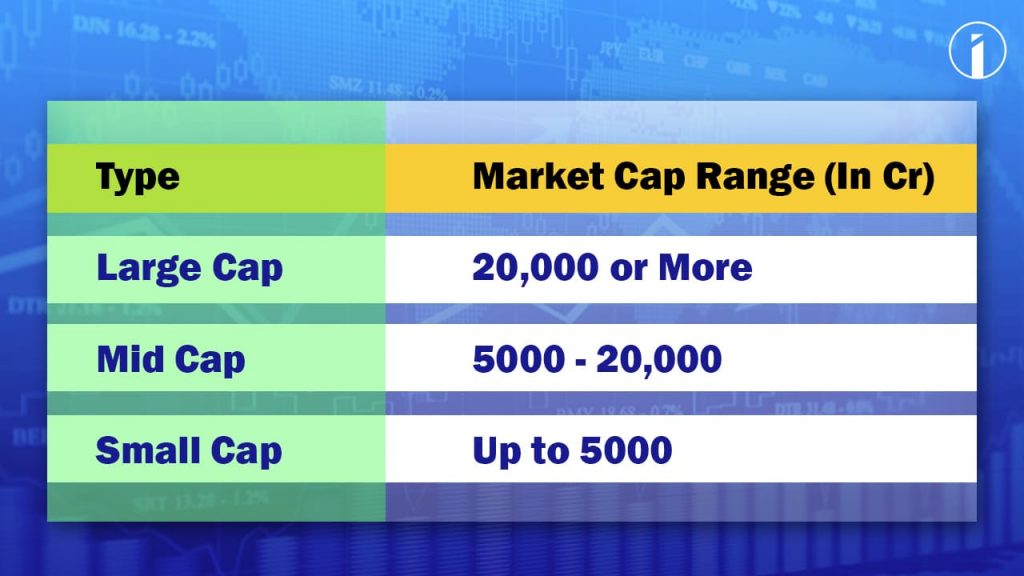For investing in the stock market, it is essential to understand how to effectively explore various types of stocks. We typically look at Market Capitalization to select the right stocks for investment. Market Capitalization of a company helps you to compare its size with other companies, making it easier to assess its relative size.
Through this blog, you will gain a complete understanding of Market Capitalization.

Let’s dive right in and explore the concept of Market Capitalization:
Market Capitalization, often referred to as “Market Cap,” is a measure of the total value of a publicly traded company’s outstanding shares of stock. Market Capitalization is a key metric used by investors, analysts, and financial professionals to evaluate companies.
How is Market Cap calculated?
The Market Cap of a company is calculated by multiplying the company’s current market price by the total number of outstanding shares of that company.
Here’s the formula to calculate market capitalization:
Market Capitalization = Current Market Price per Share × Total Number of Outstanding Shares
For example,
XYZ Ltd. with 20 lakh shares, each priced at Rs. 300, would have a market cap of Rs.600 crores. In contrast, company ABC Ltd. with a share price of Rs. 1000 and only 1 lakh shares would have a market cap of 100 crores.
- Market capitalization is typically categorized into different segments, such as large-cap, mid-cap, and small-cap, to provide investors with insights into the size and scale of companies.
In 2017, The Securities Exchange Board of India (SEBI) established criteria for categorizing stocks based on market cap.
Market Cap Ranges:

In the Indian stock market, stocks are often categorized based on their market capitalization, which refers to the total value of a company’s outstanding shares of stock. The three main categories based on market capitalization are:
1. Large-cap (Blue Chip) stocks:
Large-cap stocks are those of companies with the highest market capitalization. These companies are typically leaders in their respective industries and many of them have a track record of consistent dividend payments.
They are considered relatively stable investments and are less volatile compared to mid-cap and small-cap stocks.
2. Mid-cap stocks:
Mid-cap stocks represent companies with medium-sized market capitalization, falling between large-cap and small-cap stocks.
These companies are generally considered to have higher growth potential than large-cap stocks but may also carry more risk.
Mid-cap stocks help investors to increase their growth potentiality and stability.
3. Small-cap stocks:
Small-cap stocks belong to companies with relatively low market capitalization.
These companies are often newer or less established and may operate in niche markets or emerging industries. Small-cap stocks have the potential for high growth but also carry higher risk and greater volatility.
Investors may be attracted to small-cap stocks for their potential to outperform larger companies over the long term.
Conclusion:
It’s important for investors to consider their risk tolerance, investment objectives, and time horizon when choosing stocks from different market capitalization segments for their portfolios. Diversification across various market capitalization segments can help manage risk and potentially enhance returns over time.
FAQs
Market capitalization or market cap, measures a company’s total value in the stock market. It influences investment decisions by indicating a company’s size, risk, and growth potential. Investors use it to compare investments across different companies and sectors.
Yes. Stocks with higher market capitalization are generally more liquid due to their size. A larger market cap often correlates with higher liquidity, making it easier for investor to buy or sell without significant impact on the market price.
The market capitalization is a dynamic figure that changes daily, based on the fluctuations in stock prices and the number of outstanding shares.
It is typically calculated by multiplying the price of a stock by its total number of outstanding shares.
Yes, a large cap stock can turn into a small cap or mid cap stock and a small cap or mid cap stock can also be turned into a large cap stock based on their market price fluctuations.



Pingback: NSE and BSE Stock Series: Meaning, Difference & their Categories